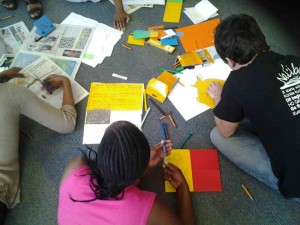 Bookmaking has the following benefits for children:
Bookmaking has the following benefits for children:
- It encourages children to take responsibility for their own learning.
- It encourages collaboration: two or more children can produce a book together by working on separate sheets of paper, which are then stuck into the book.
- Children take turns to be author and illustrator and have a great sense of achievement.
- Children see themselves as authors and/or illustrators. This motivates them to want to write more and make their next book better than the one before.
- Books are made to be read. Children think about who will read their work, and concentrate on the appearance of the book – design, illustration and handwriting.
When making books, here are some things to think about:
Page size:
- Page size is determined by the size of the paper available. If you can vary the paper, different size books can be created for different purposes, e.g. very small books to look at alone, larger ones to share, big books to read with a group.
Page layout:
- Decide how many pages you are going to use (6 pages makes a basic book, which neatly accommodates the traditional story format of beginning, middle and end).
- Decide how you are going to set out the book. Although it is more complicated to use two languages, some decisions are the same for all page designs.
Design layout:
- Is the page layout appropriate for the way the paper or other material is going to be used?
- Is the text going to be bilingual or multilingual, and are the languages treated equally?
- Is there too much text, making it difficult to read?
- Is there a clear structure with headings, captions for illustrations, etc. making it easier for the reader to navigate their way around the story?
- Have the page designs been tried on readers?
- And is the book going to be a concertina or origami book? Download instructions to make both types of books here.
Source: Information courtesy the TELL project. For more book and story making ideas, visit the TELL project, which was set up as a collaboration between PRAESA, the National Centre for Language and Literacy and the University of Reading to improve the quality of early literacy and biliteracy teaching in Early Childhood Development in South Africa and Africa.

